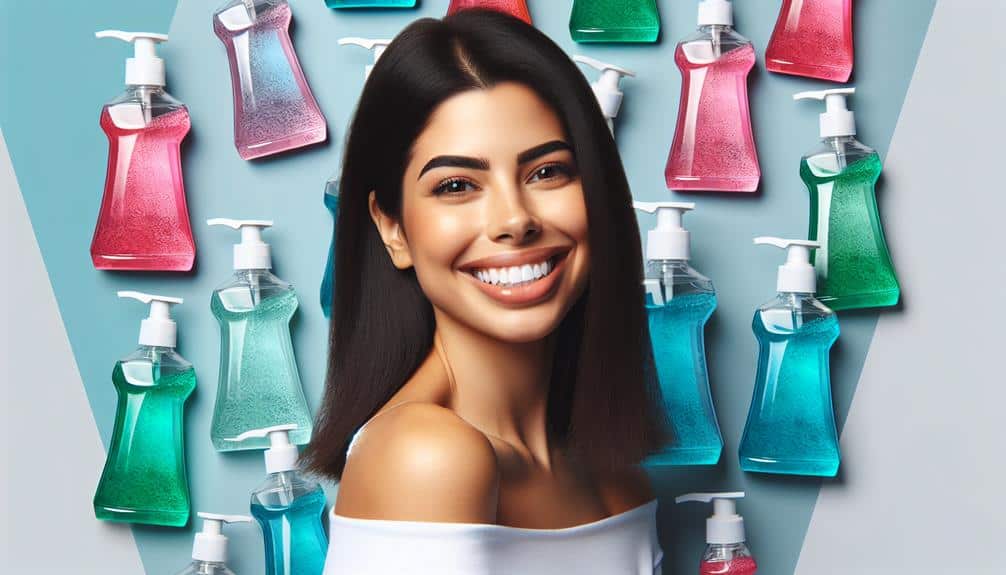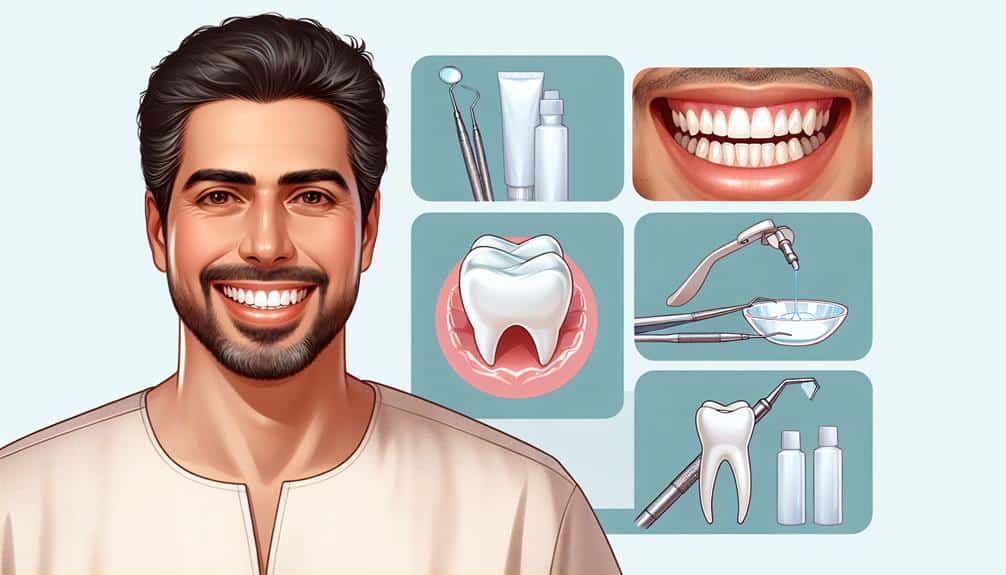Achieve a brighter smile with whitening mouthwash. Combat stains effectively for overall oral health. Choose one with effective active ingredients like hydrogen peroxide. Swish after brushing for 30 seconds daily. Opt for a gentle formula for safe use. Maximize results by pairing with proper brushing techniques and limiting sugary foods. Take the step towards a radiant smile today.
Key Points
- Use whitening mouthwash with active ingredients like hydrogen peroxide for effective stain removal.
- Swish mouthwash for at least 30 seconds after brushing and flossing for optimal results.
- Incorporate mouthwash into daily routine, preferably before bedtime, for consistent brightening effects.
- Combine mouthwash with proper brushing techniques and a balanced diet for enhanced oral health.
- Consult a dentist for personalized advice on selecting the right mouthwash for individual whitening goals.
Understanding Lifestyle-Related Stains
If you're wondering why your teeth have become stained from lifestyle habits, understanding the causes can help you make informed decisions on improving your smile. One significant factor in preventing discoloration is your dietary habits. Foods and drinks such as coffee, tea, red wine, and dark-colored berries can stain your teeth over time due to their high pigment content. These pigments adhere to the enamel, leading to discoloration. To prevent this, consider moderating your consumption of these items or using a straw to reduce contact with your teeth.
Additionally, acidic foods like citrus fruits and vinegar-based dressings can erode the enamel, making it easier for stains to set in. Ensuring good oral hygiene practices by brushing your teeth after consuming these foods and drinks is crucial. Regular dental check-ups and professional cleanings can also help prevent discoloration by removing surface stains and ensuring your oral health is in top condition.
Benefits of Whitening Mouthwash
To further enhance your efforts in combating lifestyle-related teeth stains and achieving a brighter smile, exploring the benefits of whitening mouthwash can be a valuable addition to your oral care routine. Whitening mouthwash offers a convenient and non-invasive way to help lighten surface stains on your teeth, providing a noticeable improvement in the overall brightness of your smile. One of the key advantages of whitening mouthwash is its ease of use, requiring only a minute or two as part of your daily oral hygiene regimen.
While whitening toothpaste may be abrasive and lead to enamel erosion, whitening mouthwash often contains gentle ingredients that are effective yet safe for daily use. Additionally, for individuals seeking natural alternatives or those with sensitive teeth who may not tolerate professional treatments well, whitening mouthwash can be a suitable option. However, it's essential to manage expectations as whitening mouthwash may not deliver the same level of whitening effect as professional treatments.
Choosing the Right Whitening Mouthwash
When evaluating a whitening mouthwash, examine the active ingredients for best effectiveness in brightening your smile. Different brands offer a variety of whitening mouthwashes, each with its unique formulation. When choosing between brands, search for key ingredients like hydrogen peroxide, carbamide peroxide, or sodium hexametaphosphate, known for their whitening properties.
Hydrogen peroxide, for example, is a common ingredient that can effectively whiten teeth by breaking down stains. Carbamide peroxide, on the other hand, also breaks down into hydrogen peroxide and is effective in removing surface stains. Sodium hexametaphosphate helps to prevent the formation of new stains by inhibiting the deposition of minerals on the teeth.
It's essential to take into account the ingredient effectiveness when making your selection. Some mouthwashes may focus more on freshening breath rather than whitening, so be sure to read the labels carefully. By understanding the active ingredients and their whitening mechanisms, you can choose a whitening mouthwash that aligns with your goals for a brighter smile.
How to Incorporate Mouthwash Into Your Routine
Incorporating mouthwash into your daily oral hygiene routine can enhance the overall health of your mouth and improve your oral hygiene habits. To guarantee you're using mouthwash effectively, follow these key steps:
- Proper timing: It's optimal to use mouthwash after brushing and flossing to maximize its benefits. This allows the active ingredients to reach all areas of your mouth without being diluted by toothpaste or water.
- Technique tips: Pour the recommended amount of mouthwash into a cup, swish it around your mouth for at least 30 seconds, making sure to reach all areas including between your teeth and along the gumline. Avoid swallowing the mouthwash.
- Consistency is key: Use mouthwash at least once a day, preferably before bedtime, to maintain a clean and healthy mouth.
- Choose the right mouthwash: Select a mouthwash that targets your specific needs, whether it's freshening breath, reducing plaque, or preventing cavities.
- Consult your dentist: If you have any concerns or specific oral health issues, seek advice from your dentist on the best mouthwash for your individual needs.
Tips for Maximizing Results
For best results when using mouthwash, make sure you follow these additional tips to enhance its effectiveness in improving your oral health.
When using mouthwash, it's crucial to remember that it should complement, not replace, your brushing routine. Proper brushing techniques play a crucial role in maintaining good oral hygiene. Make sure you brush your teeth at least twice a day for two minutes each time. Use a soft-bristled toothbrush and gentle, circular motions to clean all tooth surfaces effectively.
In addition to using mouthwash and following proper brushing techniques, your diet choices can also impact your oral health. Limit sugary and acidic foods and beverages as they can contribute to tooth decay and enamel erosion. Opt for a balanced diet rich in fruits, vegetables, and calcium-rich foods to promote strong teeth and gums.
Frequently Asked Questions
Can Whitening Mouthwash Be Used as a Substitute for Regular Toothpaste?
Using whitening mouthwash as a substitute for toothpaste isn't recommended. While it can freshen breath and combat stains, it lacks essential ingredients present in toothpaste for proper cleaning and protection. Stick to using it as a complement in your daily routine.
Are There Any Potential Side Effects of Using Whitening Mouthwash?
Using whitening mouthwash can lead to potential risks like tooth sensitivity, gum irritation, and enamel damage. Side effects of whitening mouthwash usage may include temporary discoloration of gums, altered taste perception, and increased tooth sensitivity.
How Long Does It Typically Take to See Noticeable Results From Using Whitening Mouthwash?
To notice a brighter smile from whitening mouthwash, results typically show in a few weeks. Consistent usage and proper dental care enhance effectiveness. Think of it like a garden; tend to it regularly for the best outcome.
Can Whitening Mouthwash Help With Stains Caused by Smoking or Drinking Coffee?
Yes, whitening mouthwash can help with tobacco stains and coffee discoloration. The active ingredients in whitening mouthwash can target these specific types of stains, gradually reducing their appearance over time with consistent use.
Is It Safe to Use Whitening Mouthwash if You Have Sensitive Teeth or Gums?
If you have sensitivity concerns or worry about your gum health, using whitening mouthwash may not be safe. The strong ingredients in whitening formulas could potentially irritate sensitive teeth and gums, causing discomfort.



